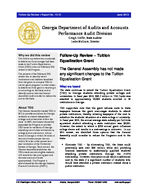Follow-Up Review Report No. 13-13
June 2013
Georgia Department of Audits and Accounts
Performance Audit Division
Greg S. Griffin, State Auditor Leslie McGuire, Director
Why we did this review
This follow-up review was conducted to determine if any changes had been made to the Tuition Equalization Grant (TEG) since our February 2011 review of the Program.
The purpose of the February 2011 review was to identify which institutions and students benefited from the grant; to compare TEG to similar grant programs in other states; to determine if the grant is resulting in a cost savings to the State; and to identify options that the General Assembly could consider to reduce the cost to the State.
About TEG
The General Assembly created TEG in 1971 to provide assistance for Georgia residents to attend independent colleges and universities within the state. In 1982, the General Assembly expanded the Program to provide TEG funds for residents of Georgia attending out-of-state institutions as college juniors and seniors, whose home in Georgia is within 50 miles of the out-of-state campus but not within 50 miles of the nearest fouryear institution of the University System of Georgia. Each session, the General Assembly establishes the TEG award amount eligible students will receive for the coming year and the total amount of funds appropriated. The Program is administered by the Georgia Student Finance Commission (GSFC).
Follow-Up Review Tuition
Equalization Grant
The General Assembly has not made
any significant changes to the Tuition
Equalization Grant
What we found The state continues to award the Tuition Equalization Grant (TEG) to Georgia students attending private colleges and universities. In fiscal year 2012, $20.7 million in TEG funds was awarded to approximately 35,000 students enrolled in 36 institutions in Georgia.
TEG supporters note that the grant reduces costs to State taxpayers because the grant encourages students to attend private institutions, thereby relieving taxpayers of the cost to subsidize the students' education at a state college or university. In fiscal year 2012, the annual average state subsidy per full-time equivalent student attending a state institution was $5,561. However, the extent to which a $700 annual grant influences college choice and results in a cost-savings is unknown. In our 2011 review, we identified three options that the General Assembly could consider to reduce the Program's cost to the State:
Eliminate TEG By eliminating TEG, the State could potentially save over $20 million while still providing financial assistance to academically qualified students attending private institutions through the HOPE Scholarship. However, this option could result in additional cost to the state if a significant number of students who would have attended a private institution instead chose a public institution.
270 Washington Street, SW, Suite 1-156
Atlanta, Georgia 30334
Phone: (404)657-5220
www.audits.ga.gov
Tuition Equalization Grant
2
Implement Eligibility Requirements TEG could be limited to students attending four-year, nonprofit institutions. Our original examination found that six of the eight states we reviewed do not award grants to students attending proprietary institutions and two-year colleges. In fiscal year 2012, Georgia awarded approximately $7.5 million in TEG funds to approximately 14,000 students attending two-year colleges and proprietary institutions. Academic and/or financial need requirements could also be implemented to reduce the number of qualifying students and decrease costs.
Revise the Grant Amount For TEG to be cost-effective, the grant award amount could be increased to a level that would influence students' decisions to attend a private institution instead of a public institution, which is more costly to the State.
None of the three options above was implemented. TEG eligibility requirements remain largely the same as 2011. Students attending proprietary (for-profit) institutions are still eligible, and there are no academic or financial need-based criteria. Students attending out-of-state institutions are no longer eligible, but these students only accounted for $9,750 of $24.3 million (.04%) grant funds awarded in fiscal year 2010. The individual grant amount was not increased to influence more students to attend a private institution. Instead, the annual award amount was decreased from $750 to $700.
In its response to our follow-up review, the Georgia Student Finance Commission indicated that it does not have any major disagreements with the report.
A copy of the 2011 review #10-09 may be accessed at http://www.audits.ga.gov/rsaAudits.
Tuition Equalization Grant
3
This page intentionally left blank
The Performance Audit Division was established in 1971 to conduct in-depth reviews of state-funded programs. Our reviews determine if programs are meeting goals and objectives; measure program results and effectiveness; identify alternate methods to meet goals; evaluate efficiency of resource allocation; assess compliance with laws and regulations; and provide credible management information to decision-makers. For more information, contact
us at (404)657-5220 or visit our website at www.audits.ga.gov.
